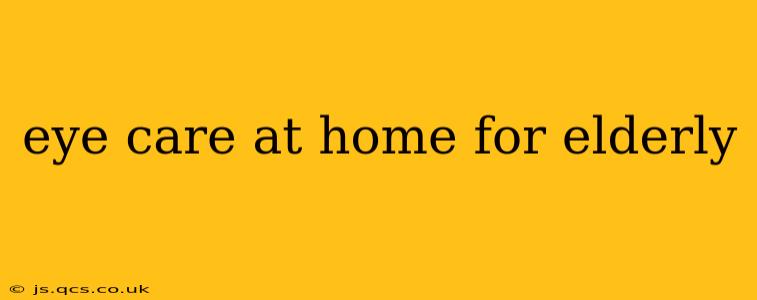Maintaining good eye health is crucial at any age, but it becomes even more important as we age. Many age-related eye conditions can impact an elderly person's quality of life, affecting their independence and overall well-being. This comprehensive guide explores simple yet effective eye care practices that can be easily implemented at home to support the visual health of your elderly loved ones.
What are the common age-related eye problems?
Several eye conditions become more prevalent with age. These include:
- Cataracts: Clouding of the eye's lens, leading to blurry vision.
- Glaucoma: Damage to the optic nerve, often due to increased pressure within the eye. This can lead to vision loss if left untreated.
- Macular Degeneration: Damage to the macula, the central part of the retina responsible for sharp, central vision. This can severely impact reading and driving abilities.
- Dry Eye Syndrome: Reduced tear production or poor tear quality, leading to discomfort, dryness, and irritation.
- Diabetic Retinopathy: Damage to the blood vessels in the retina caused by diabetes.
Regular eye exams are crucial for early detection and management of these conditions.
How can I help an elderly person with dry eyes at home?
Dry eyes are a common complaint among the elderly. Here's how to help:
- Humidify the air: Dry air exacerbates dry eyes. Using a humidifier, especially during winter months, can significantly improve comfort.
- Warm compresses: Applying warm, damp compresses to the eyelids can help soothe irritation and stimulate tear production.
- Artificial tears: Over-the-counter lubricating eye drops can provide relief from dryness and discomfort. Always check with their doctor or pharmacist for recommendations.
- Avoid eye rubbing: This can irritate the eyes further and potentially damage the cornea.
- Blink frequently: Consciously blinking more often helps distribute tears across the eye's surface.
What are some simple daily eye care routines for seniors?
Maintaining good eye hygiene is essential for preventing infections and maintaining comfort. Here are some simple routines:
- Handwashing: Always wash hands thoroughly before touching the eyes to avoid transferring germs.
- Cleanliness: Gently clean the eyelids with a clean, damp cloth to remove any debris or crusting.
- Proper lighting: Ensure adequate lighting for reading and other activities to reduce eye strain.
- Regular breaks: Encourage frequent breaks during activities that require prolonged near-vision focus, such as reading or using a computer. The 20-20-20 rule is helpful: Every 20 minutes, look at something 20 feet away for 20 seconds.
- Protective eyewear: Encourage the use of sunglasses when outdoors to protect against harmful UV rays.
How can I help prevent vision loss in the elderly?
While some age-related vision changes are inevitable, several lifestyle choices can help maintain healthy vision:
- Balanced Diet: A diet rich in fruits, vegetables, and omega-3 fatty acids is beneficial for overall eye health.
- Regular Exercise: Maintaining physical activity improves circulation, which is essential for eye health.
- Quit Smoking: Smoking significantly increases the risk of several eye diseases.
- Manage underlying health conditions: Controlling conditions like diabetes and high blood pressure is crucial in preventing eye complications.
- Regular Eye Exams: Early detection and treatment of eye conditions are key to preserving vision.
What kind of eye exercises are good for seniors?
While eye exercises won't cure existing eye conditions, they can help improve eye muscle strength and reduce eye strain. Simple exercises include:
- Focusing on near and far objects: Alternately focusing on a close object and a distant object.
- Eye rolling: Gently rolling the eyes clockwise and counterclockwise.
- Palming: Gently covering the eyes with the palms of the hands to relax the eye muscles.
Remember, this information is for general knowledge and shouldn't replace professional medical advice. It's crucial to consult an ophthalmologist or optometrist for regular eye exams and personalized recommendations for maintaining optimal eye health in the elderly. Early detection and management are key to preserving vision and quality of life.
